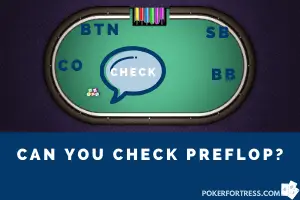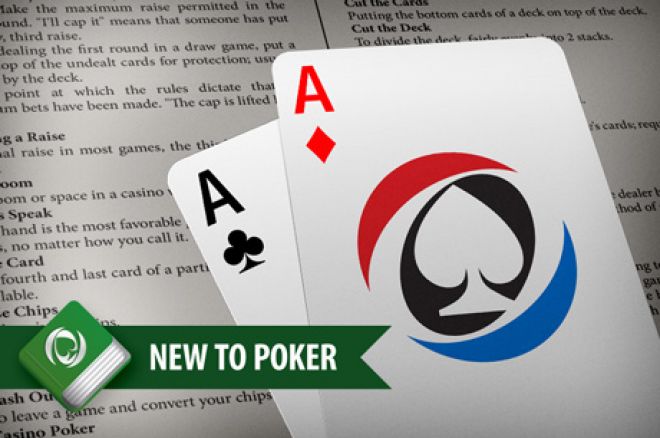When Do You Check In Poker
Do you when to check and call in poker?
- You can only check-raise when you are playing OOP. When you check in position (IP), you will just see the next community-card, and hence a check-raise is not possible. Rightly used, the check-raise is a sneaky weapon. If you aim to play game theoretical-optimal Poker, you must check-raise with good frequency’s.
- In the game of poker, the play largely centers on the act of betting, and as such, a protocol has been developed to speed up play, lessen confusion, and increase security while playing.Different games are played using different types of bets, and small variations in etiquette exist between cardrooms, but for the most part the following rules and protocol are observed by the majority of poker.
- Usually, the game rules only allow raising bets to a certain number, so when there is no betting in the round you have the choice to check and bet. When “checking” you have the chance to defer the betting option for a moment after which your opponent can choose to bet. Now, you can call or raise based on the bet placed by your opponent. This is also called check and raise where you first check and then.
In poker, players are allowed to check when no one has placed a bet before them. This means when you check, the players who occupy later positions have the option to bet, raise or check as well. If they place a bet, the action comes back to you. If you check and fold all these hands, any good player will know to simply leave you alone when you do something other then fold after a check. You have to mix up this majority with check/raises, and check/calls. Mixing up your checks in this manner requires bluffing.
Poker is one of the most played games around the world. Its popularity can be attributed to the fact that it is more than just a game; it allows its players to practice the art of agility, online casino strategy, and gambling all while building the skill set that makes a person successful at any game. However, in order to build those skills, you need to know when to use different strategies. Let’s look at how you master the art of “check and call” in a poker game.
What exactly is “check and call”?
In poker, if you don’t like the hand you are dealing with, you can choose to fold and walk away. All the money you have wagered so far will be lost with the fold. You are essentially out of the game.
But let’s assume a scenario where you want to keep dealing. If someone places a bet, you can call or raise that bet. The “call” essentially means you will raise the amount to match the current amount to see the next card. If you like your hand, you can choose to raise the bet. When you raise the bet, your opponent has the option to raise too. Usually, the game rules only allow raising bets to a certain number, so when there is no betting in the round you have the choice to check and bet. When “checking” you have the chance to defer the betting option for a moment after which your opponent can choose to bet. Now, you can call or raise based on the bet placed by your opponent. This is also called check and raise where you first check and then raise.
When to “check and call” during the game
In order to master the art of “check and call”, you need to understand when is the right time for it. Below are the 4 common scenarios where check and call is a perfect strategy.
Check and call against aggressive players:

Aggressive players can be hard to deal with. WIth them, you can usually get discriminated bets that are based on complex bluffs. In this scenario, it is better to check and then call.
Check and call on an opponent you dominate in the game:
Another scenario to check and call with an opponent is in a game where you are certain that he will fold assuming that you have the superior hand.
Check and call when you are slow playing a big hand:
If you flop a superior hand, you need more and more money in the pot to make the casino game much more exciting. You can’t tip-off the superior hand to the other players on the table so it is a good idea to check and call.
Check and call in games that are low-limit:
In case you have an uncertain hand and are up against a player who may be weak and has the possibility of carrying an unpredictable holding, it is advisable to check and call.
Final thoughts
Poker requires meticulous strategy and patience. If you are a beginner poker player, you need to learn the different rules of the game and how to strategically utilize them throughout the game to create a stronger hand that can guarantee a win. Know the rules, strategize your moves and you can have a guaranteed win.
Play NOW!
BK8 CasinoBK8 is a Registered Trade Mark, brand and registered business,
Regulated & Licensed by the Government of Curacao and

When Do You Bluff In Poker
operates under the Master License of Gaming Services
Provider, N.V. #365/JAZ
© 2018 BK8. ALL RIGHTS RESERVED
The check-raise is an important move in no-limit hold'em. The fact that check-raising is an especially aggressive play certainly makes it attractive to some players.
That said, the strategy involved when employing the check-raise successfully can be complicated, with new players in particular not always appreciating all of the factors that need to be in place in order to make the move work.
We caught up with Team PokerStars Pro Felipe Ramos at the PokerStars Championship Bahamas series this week to talk about check-raising, and he picked a hand from the European Poker Tour Prague Main Event from last month to use as an illustration to help him discuss the move.
Ramos had a nice run in the EPT Prague Main Event, making it all of the way to 15th place out of a field of 1,192. The hand Ramos chose to discuss came after the cash bubble burst when he was playing at the feature table.
The hand begins with Ramos the table's big stack with around 700,000 (about 90 big blinds). Salvatore Bonavena — who won the EPT Prague Main Event back in Season 5 (2008) — is his opponent in the hand, having just arrived at the feature table with a stack of about 350,000 (a bit over 40 big blinds).
From middle position Bonavena opened from 18,000 (a bit over 2x) and Ramos called from the big blind.
The flop came , and after checking Ramos watched as Bonavena continued for 28,000.
As Ramos explains, the situation, stack sizes, and board texture all suggest this to be a good spot for him to check-raise — regardless of Ramos's hand, in fact.
When Do You Call In Poker
However, as he points out, you don't simply want to check-raise just because you think an opponent might be bluffing. There are multiple reasons for check-raising, and you want to think about and decide if any of them apply before you do.
Ramos lists four reasons for check-raising:
- as a bluff
- for value
- as a semi-bluff
- for 'meta-game' reasons
Call And Raise In Poker
Listen to Ramos explain these points and see as well how he played the particular hand with Ramos:
When Do You Split In Poker
Tags
tournament strategycash game strategyno-limit hold’emFelipe Ramoscheck-raisingpositionblind defenseaggressionbluffingvalue bettingRelated Room
Full TiltRelated Players
Felipe Ramos